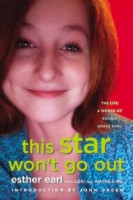Every now and then I read a book that I can’t put down and yet takes me forever to get through. Why? Because it makes me think, and worse it makes me feel far too human. “This Star Won’t Go Out” is about a life of awesome; the life of Esther Grace Earl. I have seen a few lists classify this book as a memoir, and it both is and isn’t at the same time. The reason I say this book is not a memoir is because it is actually a collection of Esther’s journal entries, blogs, poetry, fiction, and letters to those she loved as well as letters or various passages written by her friends and family, and even her doctors. Yes, I said doctors, because Esther Earl Grace had a very rare form of cancer and now she is free. But while this book features cancer it is not a story about cancer. It is not the story of a martyr or saint or a story of loss. Yes, you feel loss, the closer you come to know Esther, the heavier that loss becomes, but this is a story about a girl; not her death, but her life and her sheer awesomeness. That brings me to why this book is a memoir of sorts. A memoir is not an autobiography, but the story of a writer’s truth chronicling a specific experience or time in his or her lives. And this is Esther’s truth and as it is said in the pages; this is Esther’s book.
“This Star Won’t Go Out”
by Esther Earl, Lori Earl and Wayne Earl (January 28, 2014) ![]()
Esther’s story is one of a life that was brief, but very, very full. You can’t help but think of what she may have done if she was still here today, if she had never had cancer, but to say she was full of untapped potential minimizes everything she accomplished in her short life. One of the things that I found the most inspiring was how she led such a full life, made such an impact, when she was bedridden for years. In many ways she led a much fuller life than many people who live to old age and were never bedridden do. And that is inspiring. Even more, was not what Esther did, or the mark she left on the world, but who she was and this book allows the reader to get to know someone who was gone too soon.
John Green, author of “The Fault In Our Stars” wrote the introduction to this book, which is fitting, seeing how his bestselling novel was inspired by Esther. She is not the protagonist in Green’s book, but it was the anger caused by her death that pushed him to write the book and see it through. “I am still pissed off that she died,” Green writes in an introduction that really hit home for me. People have the habit of creating distance between people who are sick and themselves without realizing it, saying how an individual has to deal with their illness because they are strong or because God knows they can or for some greater purpose is maddening. Making someone who is sick into a martyr or putting them on a pedestal is not honoring the person, but showcasing their illness. Esther was a real person. She thought about boys and longed for her first kiss (something she never got to experience) while struggling to breathe (as in physically breathing). She would snap at people and get oversensitive as much as she would try to prepare her family for what was coming and let them know she would be all right. She had a bottomless kind of love for everyone and yet was human enough to sometimes lose her patience, have a little snark and even make judgments. Her blogs, letters and journal entries showcase Esther the person, not Esther the idol. And that is what makes this book different from many stories about childhood cancer and terminal illness (or even adult illness for that matter). Just because we’re sick, does not mean we are something other than human. It is the ‘we’ that made this book so difficult for me.
If you have read many of my posts before, you know that in 2009 and 2010 I dealt with my own terminal health crisis. I was supposed to die, what I had could not be cured and I was too far gone… and then after a year, when I told the universe to do what it had to do, but please cure me or kill me, because I wasn’t going to stop fighting – I was just better. Like, almost normal better. My organs all seemed to fix themselves at astronomical rates. Doctors called it a miracle, and it really, really was. When I read about others, like Esther who weren’t given a miracle I feel a sense of guilt. Why was I given this gift when a girl, who in my eyes was much more deserving didn’t? My impulse is to find reason somewhere where there isn’t one. So, yes, I put the book down many times to cry. To breathe again, and to reflect within myself and sort out the memories of what is on the surface, two very similar experiences. I say surface, because even if two people had the same disease, diagnosed at the same time and were on the same therapies, it would not be the same experience. But Esther dealt with fluid in her lungs, multiple chemo drugs, infections, a port, and the culprit in her death was kidney failure caused by her chemo drugs. So, with my own experiences with daily transfusions, chemo, kidney failure, infections… I understand on that superficial level, on the physical to some degree, what she had to put up with it. One key difference, I had to deal for a year, and she fought long and hard for four years. Hardly seems fair, does it?
One more thing I appreciated about this book was how Esther’s parents shared the real Esther with us. Obviously they didn’t include everything she ever wrote in this book, and yet what they chose celebrated who she was, not how some people like to remember their loved ones who have passed. I connected with her frustrations of being bedridden and physically limited (me for just over a year). I connected with her depression and when she considered ‘what if’. I connected when she would get frustrated about having to be poked several times for blood work or an IV! (I think the body just gets tired of giving up blood or being invaded and makes it difficult for even the most seasoned medical professional.) I don’t want to overemphasize her ‘flaws’ (I don’t see them as flaws, I see them as being human) because Esther was extraordinary, even though she didn’t realize it. She inspired thousands (I want to say millions, because that is what my gut is actually saying) of people. She always had a cause (several) she believed in and supported. She inspired charitable donations and people to follow her example, to love openly and with their whole heart. She was always thinking of helping others, and was desperate to make a difference. (I sincerely hope she realizes, now, wherever she is that she did make so much of a difference.) This girl was amazing, and yet this girl was also real, no pedestal necessary to see just how awesome she was.
This book was my top nonfiction pick for June before I decided to disband the noteworthy book lists. This is a book that will make you laugh. It will make you smile and feel warm, feel full of love, to give and the knowledge that you are loved. It will inspire you and it will move you. And if you are anything like me, it will make you cry (repeatedly) and mourn, it will make you question and wonder, it will make you seriously pissed off at the injustice of it all… It will feel like someone has reached into your chest and is squeezing your heart so that it hurts to breathe. But just like real life, just like love – the joy and sheer awesome that is this book and the awesome that Esther Grace Earl was, all of the good flowing through these pages makes all the bad (sorrow and anger included) worth it in the end.
-DMW








Pingback: The Miracle-Stealer | Just A Little Red